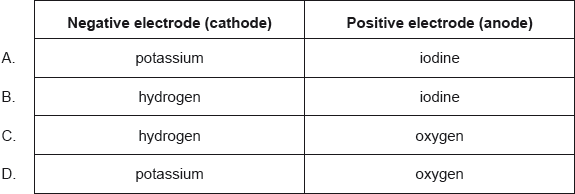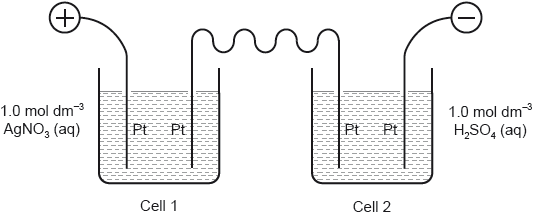| Date | May 2022 | Marks available | 1 | Reference code | 22M.2.hl.TZ2.3 |
| Level | HL | Paper | 2 | Time zone | TZ2 |
| Command term | Justify and Determine | Question number | 3 | Adapted from | N/A |
Question
Standard electrode potential values, E⦵, can be used to predict spontaneity.
Iron(II) is oxidized by bromine.
2Fe2+ (aq) + Br2 (l) 2Fe3+ (aq) + 2Br− (aq)
Calculate the E⦵cell, in V, for the reaction using section 24 of the data booklet.
Determine, giving a reason, if iodine will also oxidize iron(II).
Molten zinc chloride undergoes electrolysis in an electrolytic cell at 450 °C.
Deduce the half-equations for the reaction at each electrode.
Deduce the overall cell reaction including state symbols. Use section 7 of the data booklet.
Markscheme
« = 1.09 – 0.77 =» 0.32 «V» ✔
«2Fe2+ (aq) + 2 (s) → 2Fe3+ (aq) + 2– (aq) »
no/non-spontaneous AND «= 0.54 – 0.77 »= –0.23 «V»/
OR
no AND reduction potential of 2 lower «than Fe3+ »/ 0.54 <0.77 ✔
Accept “standard electrode potential of 2 lower /less positive than iron”.
Cathode (negative electrode):
Zn2+ + 2e− → Zn (l) ✔
Anode (positive electrode):
2Cl− → Cl2 (g) + 2e−
OR
Cl− → ½ Cl2 (g) + e− ✔
ZnCl2 (l) → Zn (l) + Cl2 (g)
balanced equation ✔
correct state symbols ✔
Accept ionic equation.
Examiners report
Only 50% got this straightforward calculation right, the most common error being to multiply both E0 values by 2, reflecting a lack of practice with this type of exercises.
Only 10% were able to correctly justify the feasibility of the reaction with I2; the MS showed the best answer using the E(v) values but also allowed simpler explanations referring to E0 of iron; even then many candidates wrote Fe+2 instead of Fe+3, understandably perhaps as this was mentioned in the question. However, it also revealed some difficulty in using and understanding data from the E0 table in the data booklet.
3(bi)/(bii) Answers to both these questions revealed that many candidates struggle to conceptualize the equations that describe electrolysis. The question asked for products of the easiest case of electrolysis, a molten salt. However, many candidates proposed oxidation or reduction equations at both electrodes, or Zn and Cl2 (with no charge) as the initial species rather than the product; the average mark was 1.2/2 as only 55% answered correctly.
3(bi)/(bii) Answers to both these questions revealed that many candidates struggle to conceptualize the equations that describe electrolysis. The question asked for products of the easiest case of electrolysis, a molten salt. However, many candidates proposed oxidation or reduction equations at both electrodes, or Zn and Cl2 (with no charge) as the initial species rather than the product; the average mark was 1.2/2 as only 55% answered correctly.
The determination of the states proved to be even more difficult, with many stating the ions were aqueous in spite of the fact that the question is clearly about molten zinc chloride. Allowing ECF for the overall equation allowed marks for many candidates, but very few realised that both ionic species in ZnCl2 were actually liquid (being a molten salt). As a result, correct answers were below 45% and the average mark was 0.9/2.



